Physical Exercise and Psychological Wellbeing: Depression and Anxiety
VerifiedAdded on 2021/04/19
|13
|3730
|79
Essay
AI Summary
This essay delves into the critical relationship between physical exercise and psychological wellbeing, with a specific focus on depression and anxiety. It explores how physical activity serves as a potent tool in combating mental health issues, supported by research highlighting the benefits of exercise in reducing depressive symptoms. The paper examines the repercussions of depression in the sports field, including the impact of injuries and personal life events on athletes' mental health. It also discusses the significance of incorporating physical exercise as a fundamental component in addressing and mitigating the effects of depression and anxiety, emphasizing the role of the Ryff Scales of Psychological Well-being and the potential for overtraining syndrome. Furthermore, the essay underscores the importance of promoting psychological wellbeing, particularly among vulnerable groups like children and adolescents, and advocates for the integration of physical exercise into educational frameworks to combat mental illness.
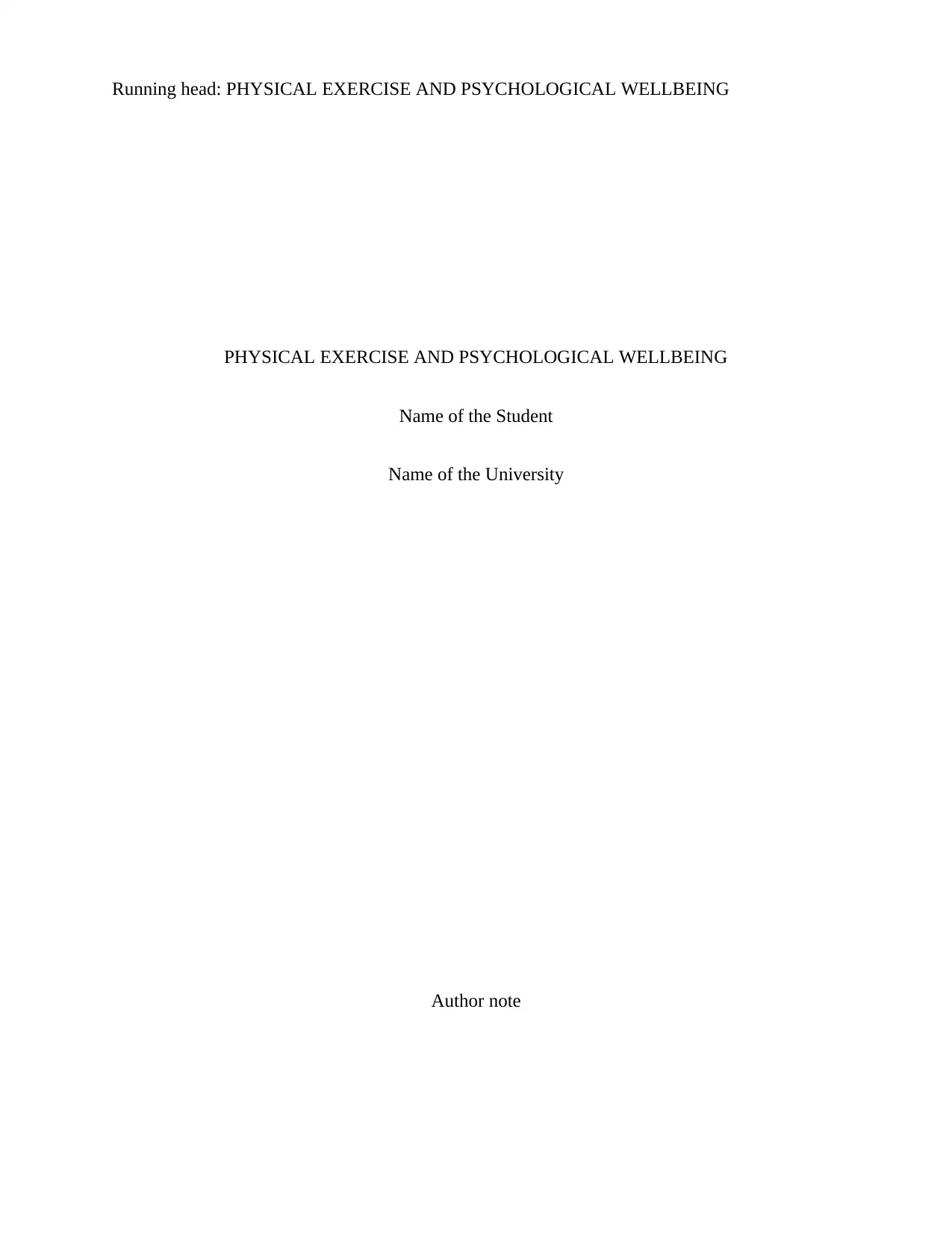
Running head: PHYSICAL EXERCISE AND PSYCHOLOGICAL WELLBEING
PHYSICAL EXERCISE AND PSYCHOLOGICAL WELLBEING
Name of the Student
Name of the University
Author note
PHYSICAL EXERCISE AND PSYCHOLOGICAL WELLBEING
Name of the Student
Name of the University
Author note
Paraphrase This Document
Need a fresh take? Get an instant paraphrase of this document with our AI Paraphraser
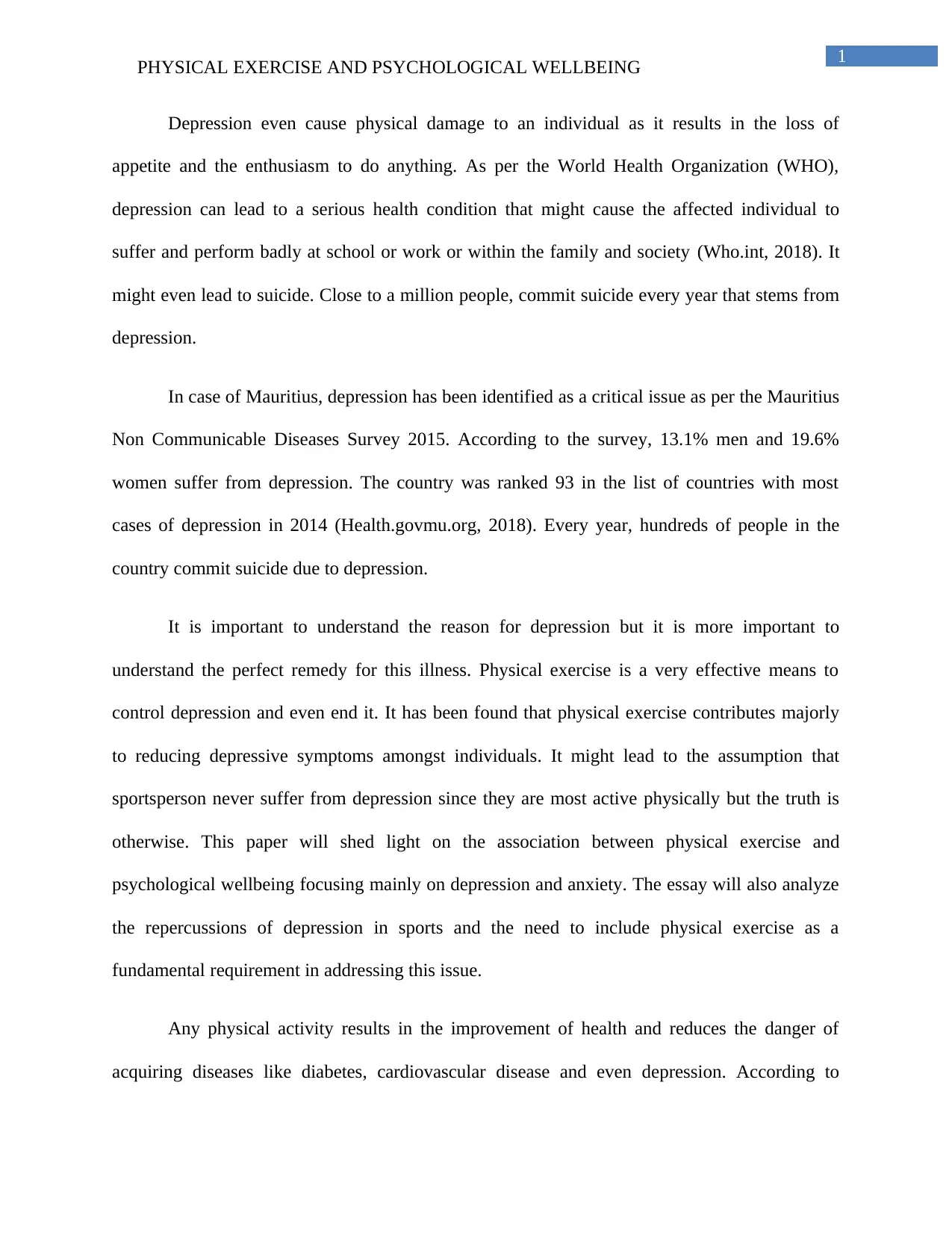
1
PHYSICAL EXERCISE AND PSYCHOLOGICAL WELLBEING
Depression even cause physical damage to an individual as it results in the loss of
appetite and the enthusiasm to do anything. As per the World Health Organization (WHO),
depression can lead to a serious health condition that might cause the affected individual to
suffer and perform badly at school or work or within the family and society (Who.int, 2018). It
might even lead to suicide. Close to a million people, commit suicide every year that stems from
depression.
In case of Mauritius, depression has been identified as a critical issue as per the Mauritius
Non Communicable Diseases Survey 2015. According to the survey, 13.1% men and 19.6%
women suffer from depression. The country was ranked 93 in the list of countries with most
cases of depression in 2014 (Health.govmu.org, 2018). Every year, hundreds of people in the
country commit suicide due to depression.
It is important to understand the reason for depression but it is more important to
understand the perfect remedy for this illness. Physical exercise is a very effective means to
control depression and even end it. It has been found that physical exercise contributes majorly
to reducing depressive symptoms amongst individuals. It might lead to the assumption that
sportsperson never suffer from depression since they are most active physically but the truth is
otherwise. This paper will shed light on the association between physical exercise and
psychological wellbeing focusing mainly on depression and anxiety. The essay will also analyze
the repercussions of depression in sports and the need to include physical exercise as a
fundamental requirement in addressing this issue.
Any physical activity results in the improvement of health and reduces the danger of
acquiring diseases like diabetes, cardiovascular disease and even depression. According to
PHYSICAL EXERCISE AND PSYCHOLOGICAL WELLBEING
Depression even cause physical damage to an individual as it results in the loss of
appetite and the enthusiasm to do anything. As per the World Health Organization (WHO),
depression can lead to a serious health condition that might cause the affected individual to
suffer and perform badly at school or work or within the family and society (Who.int, 2018). It
might even lead to suicide. Close to a million people, commit suicide every year that stems from
depression.
In case of Mauritius, depression has been identified as a critical issue as per the Mauritius
Non Communicable Diseases Survey 2015. According to the survey, 13.1% men and 19.6%
women suffer from depression. The country was ranked 93 in the list of countries with most
cases of depression in 2014 (Health.govmu.org, 2018). Every year, hundreds of people in the
country commit suicide due to depression.
It is important to understand the reason for depression but it is more important to
understand the perfect remedy for this illness. Physical exercise is a very effective means to
control depression and even end it. It has been found that physical exercise contributes majorly
to reducing depressive symptoms amongst individuals. It might lead to the assumption that
sportsperson never suffer from depression since they are most active physically but the truth is
otherwise. This paper will shed light on the association between physical exercise and
psychological wellbeing focusing mainly on depression and anxiety. The essay will also analyze
the repercussions of depression in sports and the need to include physical exercise as a
fundamental requirement in addressing this issue.
Any physical activity results in the improvement of health and reduces the danger of
acquiring diseases like diabetes, cardiovascular disease and even depression. According to
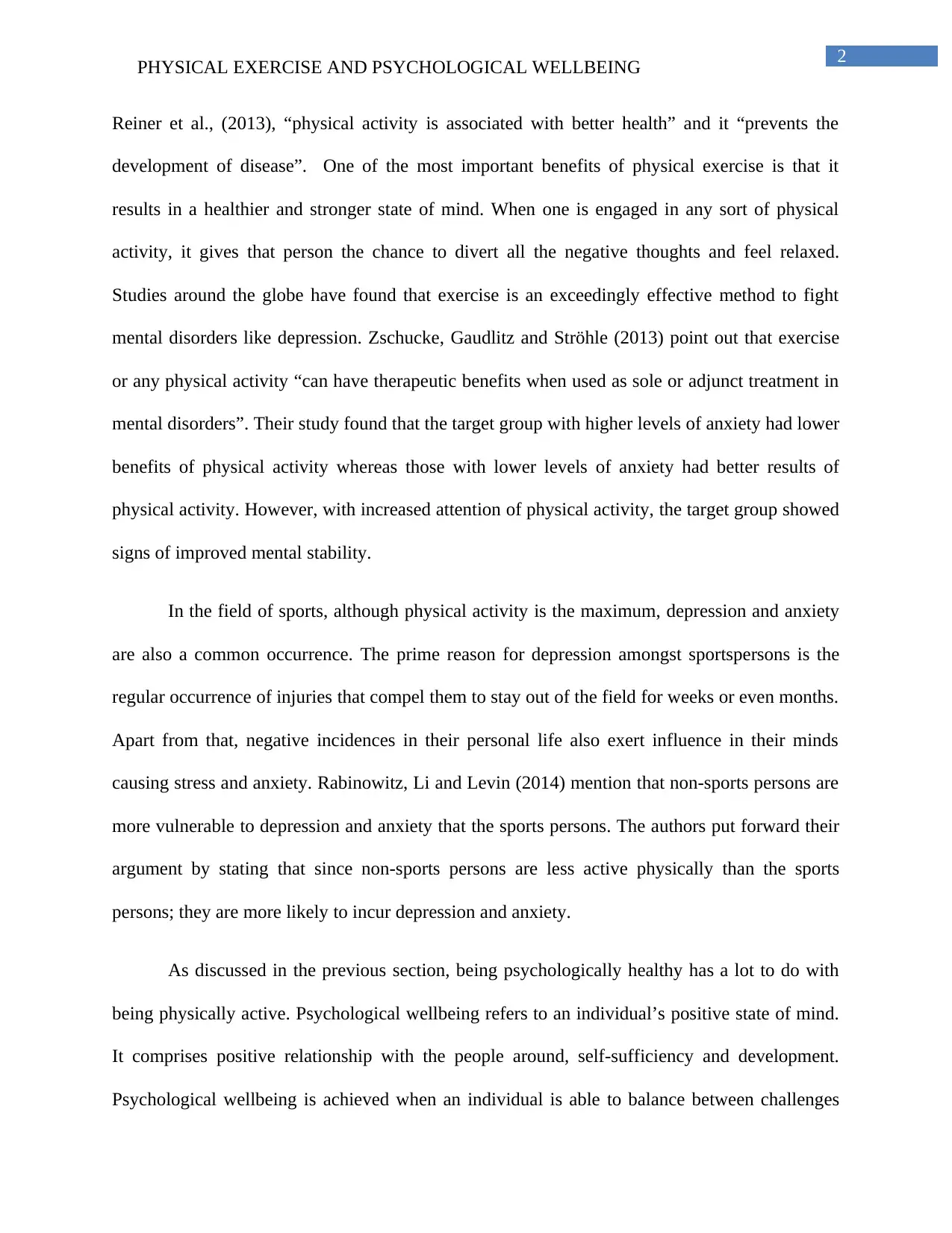
2
PHYSICAL EXERCISE AND PSYCHOLOGICAL WELLBEING
Reiner et al., (2013), “physical activity is associated with better health” and it “prevents the
development of disease”. One of the most important benefits of physical exercise is that it
results in a healthier and stronger state of mind. When one is engaged in any sort of physical
activity, it gives that person the chance to divert all the negative thoughts and feel relaxed.
Studies around the globe have found that exercise is an exceedingly effective method to fight
mental disorders like depression. Zschucke, Gaudlitz and Ströhle (2013) point out that exercise
or any physical activity “can have therapeutic benefits when used as sole or adjunct treatment in
mental disorders”. Their study found that the target group with higher levels of anxiety had lower
benefits of physical activity whereas those with lower levels of anxiety had better results of
physical activity. However, with increased attention of physical activity, the target group showed
signs of improved mental stability.
In the field of sports, although physical activity is the maximum, depression and anxiety
are also a common occurrence. The prime reason for depression amongst sportspersons is the
regular occurrence of injuries that compel them to stay out of the field for weeks or even months.
Apart from that, negative incidences in their personal life also exert influence in their minds
causing stress and anxiety. Rabinowitz, Li and Levin (2014) mention that non-sports persons are
more vulnerable to depression and anxiety that the sports persons. The authors put forward their
argument by stating that since non-sports persons are less active physically than the sports
persons; they are more likely to incur depression and anxiety.
As discussed in the previous section, being psychologically healthy has a lot to do with
being physically active. Psychological wellbeing refers to an individual’s positive state of mind.
It comprises positive relationship with the people around, self-sufficiency and development.
Psychological wellbeing is achieved when an individual is able to balance between challenges
PHYSICAL EXERCISE AND PSYCHOLOGICAL WELLBEING
Reiner et al., (2013), “physical activity is associated with better health” and it “prevents the
development of disease”. One of the most important benefits of physical exercise is that it
results in a healthier and stronger state of mind. When one is engaged in any sort of physical
activity, it gives that person the chance to divert all the negative thoughts and feel relaxed.
Studies around the globe have found that exercise is an exceedingly effective method to fight
mental disorders like depression. Zschucke, Gaudlitz and Ströhle (2013) point out that exercise
or any physical activity “can have therapeutic benefits when used as sole or adjunct treatment in
mental disorders”. Their study found that the target group with higher levels of anxiety had lower
benefits of physical activity whereas those with lower levels of anxiety had better results of
physical activity. However, with increased attention of physical activity, the target group showed
signs of improved mental stability.
In the field of sports, although physical activity is the maximum, depression and anxiety
are also a common occurrence. The prime reason for depression amongst sportspersons is the
regular occurrence of injuries that compel them to stay out of the field for weeks or even months.
Apart from that, negative incidences in their personal life also exert influence in their minds
causing stress and anxiety. Rabinowitz, Li and Levin (2014) mention that non-sports persons are
more vulnerable to depression and anxiety that the sports persons. The authors put forward their
argument by stating that since non-sports persons are less active physically than the sports
persons; they are more likely to incur depression and anxiety.
As discussed in the previous section, being psychologically healthy has a lot to do with
being physically active. Psychological wellbeing refers to an individual’s positive state of mind.
It comprises positive relationship with the people around, self-sufficiency and development.
Psychological wellbeing is achieved when an individual is able to balance between challenges
⊘ This is a preview!⊘
Do you want full access?
Subscribe today to unlock all pages.

Trusted by 1+ million students worldwide
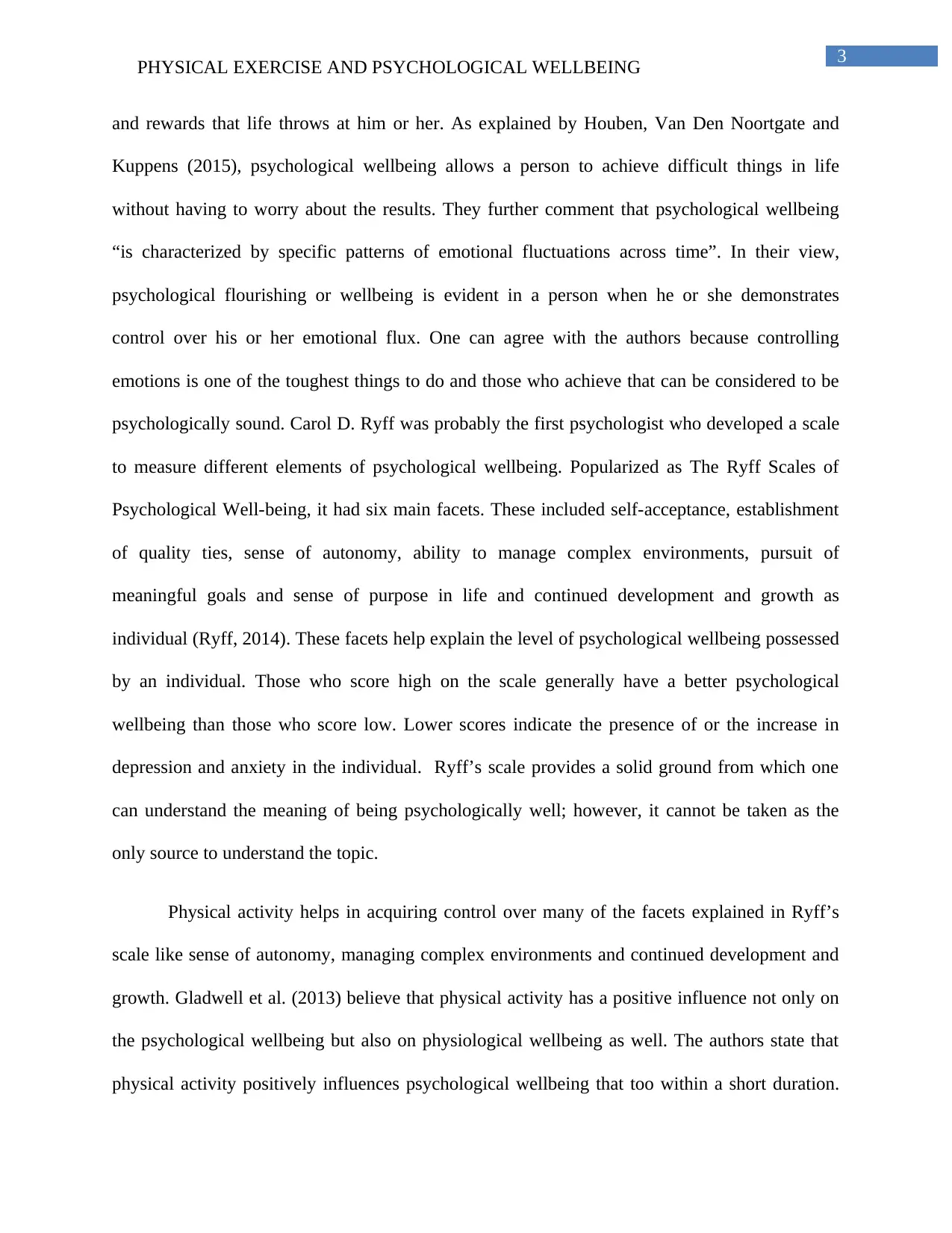
3
PHYSICAL EXERCISE AND PSYCHOLOGICAL WELLBEING
and rewards that life throws at him or her. As explained by Houben, Van Den Noortgate and
Kuppens (2015), psychological wellbeing allows a person to achieve difficult things in life
without having to worry about the results. They further comment that psychological wellbeing
“is characterized by specific patterns of emotional fluctuations across time”. In their view,
psychological flourishing or wellbeing is evident in a person when he or she demonstrates
control over his or her emotional flux. One can agree with the authors because controlling
emotions is one of the toughest things to do and those who achieve that can be considered to be
psychologically sound. Carol D. Ryff was probably the first psychologist who developed a scale
to measure different elements of psychological wellbeing. Popularized as The Ryff Scales of
Psychological Well-being, it had six main facets. These included self-acceptance, establishment
of quality ties, sense of autonomy, ability to manage complex environments, pursuit of
meaningful goals and sense of purpose in life and continued development and growth as
individual (Ryff, 2014). These facets help explain the level of psychological wellbeing possessed
by an individual. Those who score high on the scale generally have a better psychological
wellbeing than those who score low. Lower scores indicate the presence of or the increase in
depression and anxiety in the individual. Ryff’s scale provides a solid ground from which one
can understand the meaning of being psychologically well; however, it cannot be taken as the
only source to understand the topic.
Physical activity helps in acquiring control over many of the facets explained in Ryff’s
scale like sense of autonomy, managing complex environments and continued development and
growth. Gladwell et al. (2013) believe that physical activity has a positive influence not only on
the psychological wellbeing but also on physiological wellbeing as well. The authors state that
physical activity positively influences psychological wellbeing that too within a short duration.
PHYSICAL EXERCISE AND PSYCHOLOGICAL WELLBEING
and rewards that life throws at him or her. As explained by Houben, Van Den Noortgate and
Kuppens (2015), psychological wellbeing allows a person to achieve difficult things in life
without having to worry about the results. They further comment that psychological wellbeing
“is characterized by specific patterns of emotional fluctuations across time”. In their view,
psychological flourishing or wellbeing is evident in a person when he or she demonstrates
control over his or her emotional flux. One can agree with the authors because controlling
emotions is one of the toughest things to do and those who achieve that can be considered to be
psychologically sound. Carol D. Ryff was probably the first psychologist who developed a scale
to measure different elements of psychological wellbeing. Popularized as The Ryff Scales of
Psychological Well-being, it had six main facets. These included self-acceptance, establishment
of quality ties, sense of autonomy, ability to manage complex environments, pursuit of
meaningful goals and sense of purpose in life and continued development and growth as
individual (Ryff, 2014). These facets help explain the level of psychological wellbeing possessed
by an individual. Those who score high on the scale generally have a better psychological
wellbeing than those who score low. Lower scores indicate the presence of or the increase in
depression and anxiety in the individual. Ryff’s scale provides a solid ground from which one
can understand the meaning of being psychologically well; however, it cannot be taken as the
only source to understand the topic.
Physical activity helps in acquiring control over many of the facets explained in Ryff’s
scale like sense of autonomy, managing complex environments and continued development and
growth. Gladwell et al. (2013) believe that physical activity has a positive influence not only on
the psychological wellbeing but also on physiological wellbeing as well. The authors state that
physical activity positively influences psychological wellbeing that too within a short duration.
Paraphrase This Document
Need a fresh take? Get an instant paraphrase of this document with our AI Paraphraser
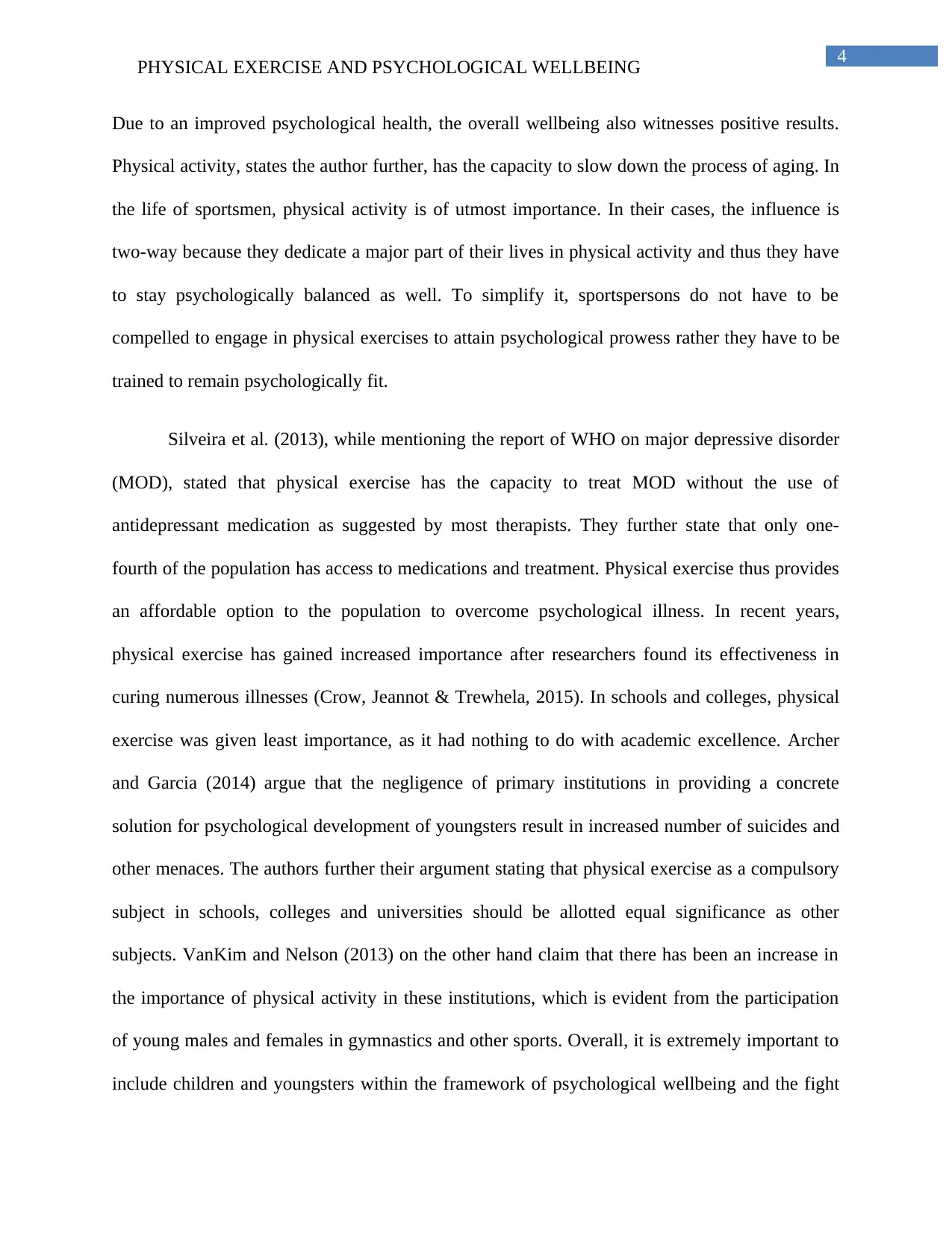
4
PHYSICAL EXERCISE AND PSYCHOLOGICAL WELLBEING
Due to an improved psychological health, the overall wellbeing also witnesses positive results.
Physical activity, states the author further, has the capacity to slow down the process of aging. In
the life of sportsmen, physical activity is of utmost importance. In their cases, the influence is
two-way because they dedicate a major part of their lives in physical activity and thus they have
to stay psychologically balanced as well. To simplify it, sportspersons do not have to be
compelled to engage in physical exercises to attain psychological prowess rather they have to be
trained to remain psychologically fit.
Silveira et al. (2013), while mentioning the report of WHO on major depressive disorder
(MOD), stated that physical exercise has the capacity to treat MOD without the use of
antidepressant medication as suggested by most therapists. They further state that only one-
fourth of the population has access to medications and treatment. Physical exercise thus provides
an affordable option to the population to overcome psychological illness. In recent years,
physical exercise has gained increased importance after researchers found its effectiveness in
curing numerous illnesses (Crow, Jeannot & Trewhela, 2015). In schools and colleges, physical
exercise was given least importance, as it had nothing to do with academic excellence. Archer
and Garcia (2014) argue that the negligence of primary institutions in providing a concrete
solution for psychological development of youngsters result in increased number of suicides and
other menaces. The authors further their argument stating that physical exercise as a compulsory
subject in schools, colleges and universities should be allotted equal significance as other
subjects. VanKim and Nelson (2013) on the other hand claim that there has been an increase in
the importance of physical activity in these institutions, which is evident from the participation
of young males and females in gymnastics and other sports. Overall, it is extremely important to
include children and youngsters within the framework of psychological wellbeing and the fight
PHYSICAL EXERCISE AND PSYCHOLOGICAL WELLBEING
Due to an improved psychological health, the overall wellbeing also witnesses positive results.
Physical activity, states the author further, has the capacity to slow down the process of aging. In
the life of sportsmen, physical activity is of utmost importance. In their cases, the influence is
two-way because they dedicate a major part of their lives in physical activity and thus they have
to stay psychologically balanced as well. To simplify it, sportspersons do not have to be
compelled to engage in physical exercises to attain psychological prowess rather they have to be
trained to remain psychologically fit.
Silveira et al. (2013), while mentioning the report of WHO on major depressive disorder
(MOD), stated that physical exercise has the capacity to treat MOD without the use of
antidepressant medication as suggested by most therapists. They further state that only one-
fourth of the population has access to medications and treatment. Physical exercise thus provides
an affordable option to the population to overcome psychological illness. In recent years,
physical exercise has gained increased importance after researchers found its effectiveness in
curing numerous illnesses (Crow, Jeannot & Trewhela, 2015). In schools and colleges, physical
exercise was given least importance, as it had nothing to do with academic excellence. Archer
and Garcia (2014) argue that the negligence of primary institutions in providing a concrete
solution for psychological development of youngsters result in increased number of suicides and
other menaces. The authors further their argument stating that physical exercise as a compulsory
subject in schools, colleges and universities should be allotted equal significance as other
subjects. VanKim and Nelson (2013) on the other hand claim that there has been an increase in
the importance of physical activity in these institutions, which is evident from the participation
of young males and females in gymnastics and other sports. Overall, it is extremely important to
include children and youngsters within the framework of psychological wellbeing and the fight
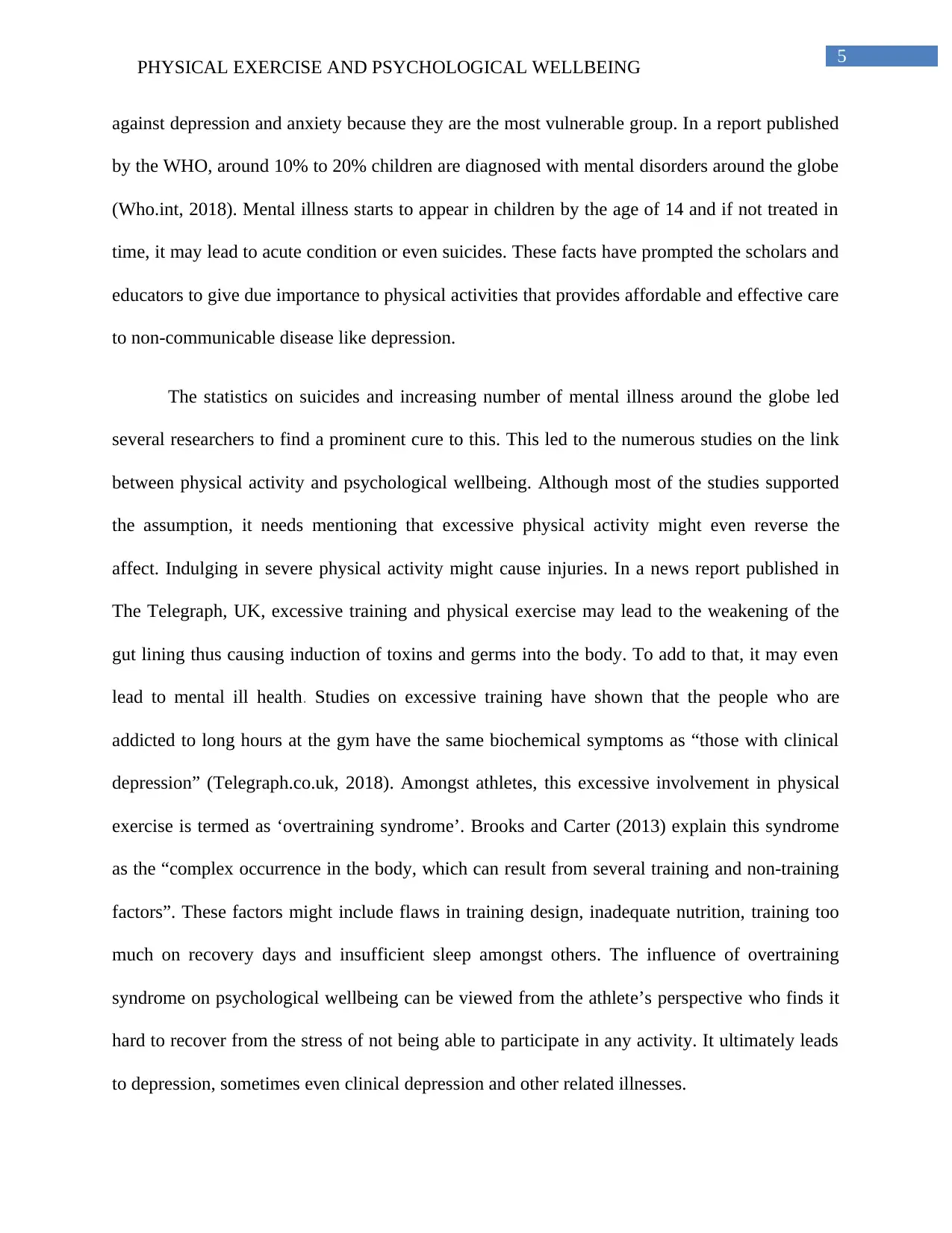
5
PHYSICAL EXERCISE AND PSYCHOLOGICAL WELLBEING
against depression and anxiety because they are the most vulnerable group. In a report published
by the WHO, around 10% to 20% children are diagnosed with mental disorders around the globe
(Who.int, 2018). Mental illness starts to appear in children by the age of 14 and if not treated in
time, it may lead to acute condition or even suicides. These facts have prompted the scholars and
educators to give due importance to physical activities that provides affordable and effective care
to non-communicable disease like depression.
The statistics on suicides and increasing number of mental illness around the globe led
several researchers to find a prominent cure to this. This led to the numerous studies on the link
between physical activity and psychological wellbeing. Although most of the studies supported
the assumption, it needs mentioning that excessive physical activity might even reverse the
affect. Indulging in severe physical activity might cause injuries. In a news report published in
The Telegraph, UK, excessive training and physical exercise may lead to the weakening of the
gut lining thus causing induction of toxins and germs into the body. To add to that, it may even
lead to mental ill health. Studies on excessive training have shown that the people who are
addicted to long hours at the gym have the same biochemical symptoms as “those with clinical
depression” (Telegraph.co.uk, 2018). Amongst athletes, this excessive involvement in physical
exercise is termed as ‘overtraining syndrome’. Brooks and Carter (2013) explain this syndrome
as the “complex occurrence in the body, which can result from several training and non-training
factors”. These factors might include flaws in training design, inadequate nutrition, training too
much on recovery days and insufficient sleep amongst others. The influence of overtraining
syndrome on psychological wellbeing can be viewed from the athlete’s perspective who finds it
hard to recover from the stress of not being able to participate in any activity. It ultimately leads
to depression, sometimes even clinical depression and other related illnesses.
PHYSICAL EXERCISE AND PSYCHOLOGICAL WELLBEING
against depression and anxiety because they are the most vulnerable group. In a report published
by the WHO, around 10% to 20% children are diagnosed with mental disorders around the globe
(Who.int, 2018). Mental illness starts to appear in children by the age of 14 and if not treated in
time, it may lead to acute condition or even suicides. These facts have prompted the scholars and
educators to give due importance to physical activities that provides affordable and effective care
to non-communicable disease like depression.
The statistics on suicides and increasing number of mental illness around the globe led
several researchers to find a prominent cure to this. This led to the numerous studies on the link
between physical activity and psychological wellbeing. Although most of the studies supported
the assumption, it needs mentioning that excessive physical activity might even reverse the
affect. Indulging in severe physical activity might cause injuries. In a news report published in
The Telegraph, UK, excessive training and physical exercise may lead to the weakening of the
gut lining thus causing induction of toxins and germs into the body. To add to that, it may even
lead to mental ill health. Studies on excessive training have shown that the people who are
addicted to long hours at the gym have the same biochemical symptoms as “those with clinical
depression” (Telegraph.co.uk, 2018). Amongst athletes, this excessive involvement in physical
exercise is termed as ‘overtraining syndrome’. Brooks and Carter (2013) explain this syndrome
as the “complex occurrence in the body, which can result from several training and non-training
factors”. These factors might include flaws in training design, inadequate nutrition, training too
much on recovery days and insufficient sleep amongst others. The influence of overtraining
syndrome on psychological wellbeing can be viewed from the athlete’s perspective who finds it
hard to recover from the stress of not being able to participate in any activity. It ultimately leads
to depression, sometimes even clinical depression and other related illnesses.
⊘ This is a preview!⊘
Do you want full access?
Subscribe today to unlock all pages.

Trusted by 1+ million students worldwide
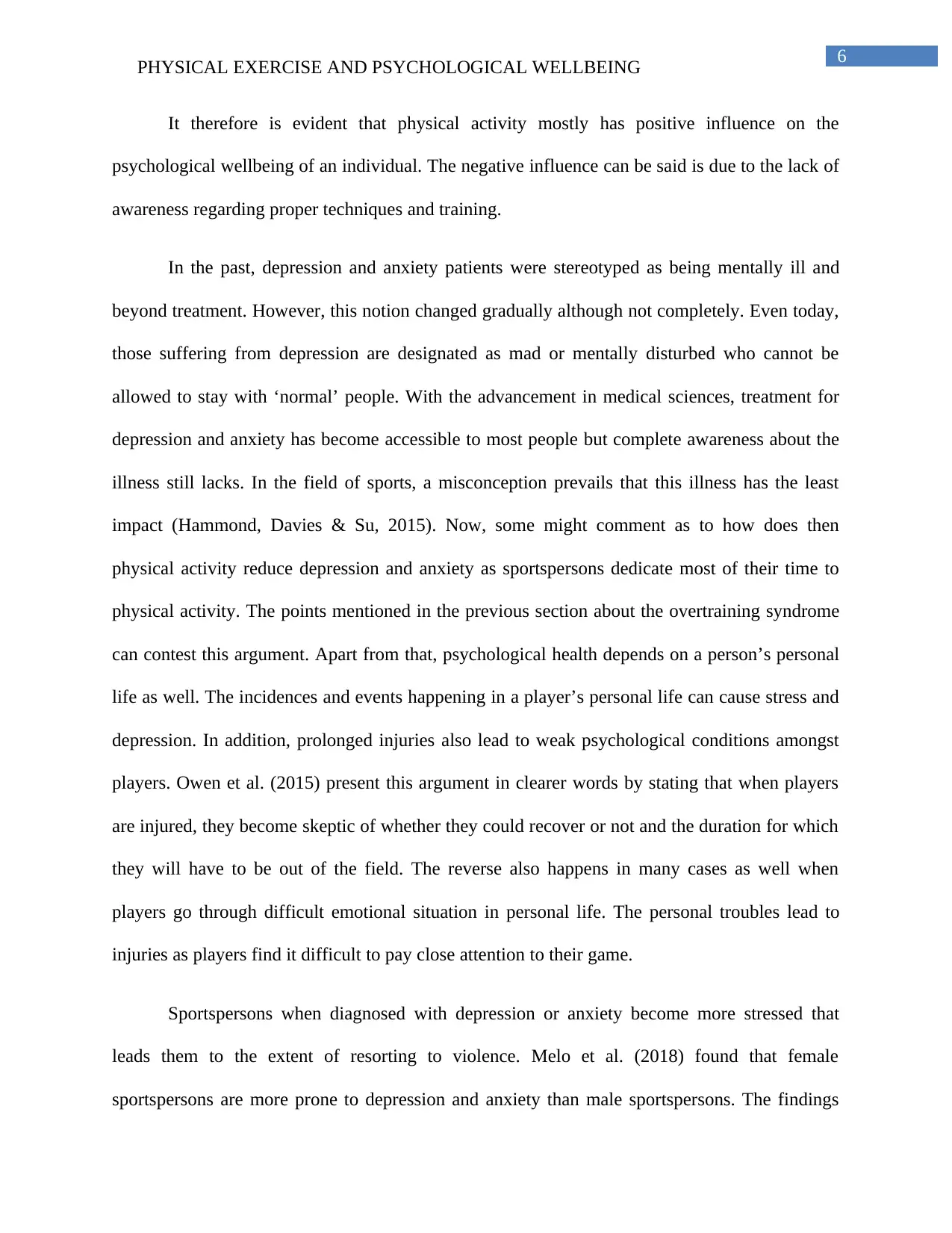
6
PHYSICAL EXERCISE AND PSYCHOLOGICAL WELLBEING
It therefore is evident that physical activity mostly has positive influence on the
psychological wellbeing of an individual. The negative influence can be said is due to the lack of
awareness regarding proper techniques and training.
In the past, depression and anxiety patients were stereotyped as being mentally ill and
beyond treatment. However, this notion changed gradually although not completely. Even today,
those suffering from depression are designated as mad or mentally disturbed who cannot be
allowed to stay with ‘normal’ people. With the advancement in medical sciences, treatment for
depression and anxiety has become accessible to most people but complete awareness about the
illness still lacks. In the field of sports, a misconception prevails that this illness has the least
impact (Hammond, Davies & Su, 2015). Now, some might comment as to how does then
physical activity reduce depression and anxiety as sportspersons dedicate most of their time to
physical activity. The points mentioned in the previous section about the overtraining syndrome
can contest this argument. Apart from that, psychological health depends on a person’s personal
life as well. The incidences and events happening in a player’s personal life can cause stress and
depression. In addition, prolonged injuries also lead to weak psychological conditions amongst
players. Owen et al. (2015) present this argument in clearer words by stating that when players
are injured, they become skeptic of whether they could recover or not and the duration for which
they will have to be out of the field. The reverse also happens in many cases as well when
players go through difficult emotional situation in personal life. The personal troubles lead to
injuries as players find it difficult to pay close attention to their game.
Sportspersons when diagnosed with depression or anxiety become more stressed that
leads them to the extent of resorting to violence. Melo et al. (2018) found that female
sportspersons are more prone to depression and anxiety than male sportspersons. The findings
PHYSICAL EXERCISE AND PSYCHOLOGICAL WELLBEING
It therefore is evident that physical activity mostly has positive influence on the
psychological wellbeing of an individual. The negative influence can be said is due to the lack of
awareness regarding proper techniques and training.
In the past, depression and anxiety patients were stereotyped as being mentally ill and
beyond treatment. However, this notion changed gradually although not completely. Even today,
those suffering from depression are designated as mad or mentally disturbed who cannot be
allowed to stay with ‘normal’ people. With the advancement in medical sciences, treatment for
depression and anxiety has become accessible to most people but complete awareness about the
illness still lacks. In the field of sports, a misconception prevails that this illness has the least
impact (Hammond, Davies & Su, 2015). Now, some might comment as to how does then
physical activity reduce depression and anxiety as sportspersons dedicate most of their time to
physical activity. The points mentioned in the previous section about the overtraining syndrome
can contest this argument. Apart from that, psychological health depends on a person’s personal
life as well. The incidences and events happening in a player’s personal life can cause stress and
depression. In addition, prolonged injuries also lead to weak psychological conditions amongst
players. Owen et al. (2015) present this argument in clearer words by stating that when players
are injured, they become skeptic of whether they could recover or not and the duration for which
they will have to be out of the field. The reverse also happens in many cases as well when
players go through difficult emotional situation in personal life. The personal troubles lead to
injuries as players find it difficult to pay close attention to their game.
Sportspersons when diagnosed with depression or anxiety become more stressed that
leads them to the extent of resorting to violence. Melo et al. (2018) found that female
sportspersons are more prone to depression and anxiety than male sportspersons. The findings
Paraphrase This Document
Need a fresh take? Get an instant paraphrase of this document with our AI Paraphraser
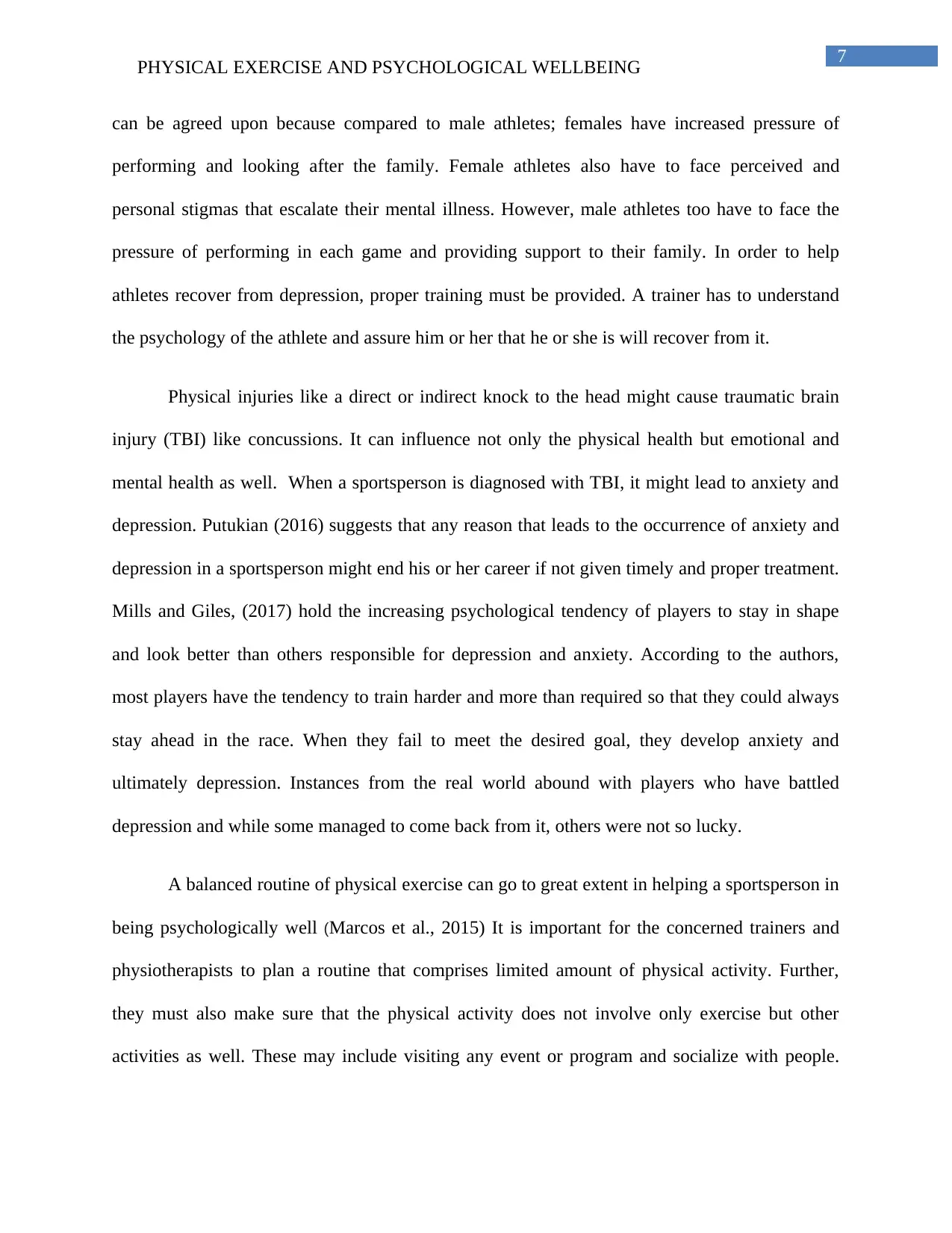
7
PHYSICAL EXERCISE AND PSYCHOLOGICAL WELLBEING
can be agreed upon because compared to male athletes; females have increased pressure of
performing and looking after the family. Female athletes also have to face perceived and
personal stigmas that escalate their mental illness. However, male athletes too have to face the
pressure of performing in each game and providing support to their family. In order to help
athletes recover from depression, proper training must be provided. A trainer has to understand
the psychology of the athlete and assure him or her that he or she is will recover from it.
Physical injuries like a direct or indirect knock to the head might cause traumatic brain
injury (TBI) like concussions. It can influence not only the physical health but emotional and
mental health as well. When a sportsperson is diagnosed with TBI, it might lead to anxiety and
depression. Putukian (2016) suggests that any reason that leads to the occurrence of anxiety and
depression in a sportsperson might end his or her career if not given timely and proper treatment.
Mills and Giles, (2017) hold the increasing psychological tendency of players to stay in shape
and look better than others responsible for depression and anxiety. According to the authors,
most players have the tendency to train harder and more than required so that they could always
stay ahead in the race. When they fail to meet the desired goal, they develop anxiety and
ultimately depression. Instances from the real world abound with players who have battled
depression and while some managed to come back from it, others were not so lucky.
A balanced routine of physical exercise can go to great extent in helping a sportsperson in
being psychologically well (Marcos et al., 2015) It is important for the concerned trainers and
physiotherapists to plan a routine that comprises limited amount of physical activity. Further,
they must also make sure that the physical activity does not involve only exercise but other
activities as well. These may include visiting any event or program and socialize with people.
PHYSICAL EXERCISE AND PSYCHOLOGICAL WELLBEING
can be agreed upon because compared to male athletes; females have increased pressure of
performing and looking after the family. Female athletes also have to face perceived and
personal stigmas that escalate their mental illness. However, male athletes too have to face the
pressure of performing in each game and providing support to their family. In order to help
athletes recover from depression, proper training must be provided. A trainer has to understand
the psychology of the athlete and assure him or her that he or she is will recover from it.
Physical injuries like a direct or indirect knock to the head might cause traumatic brain
injury (TBI) like concussions. It can influence not only the physical health but emotional and
mental health as well. When a sportsperson is diagnosed with TBI, it might lead to anxiety and
depression. Putukian (2016) suggests that any reason that leads to the occurrence of anxiety and
depression in a sportsperson might end his or her career if not given timely and proper treatment.
Mills and Giles, (2017) hold the increasing psychological tendency of players to stay in shape
and look better than others responsible for depression and anxiety. According to the authors,
most players have the tendency to train harder and more than required so that they could always
stay ahead in the race. When they fail to meet the desired goal, they develop anxiety and
ultimately depression. Instances from the real world abound with players who have battled
depression and while some managed to come back from it, others were not so lucky.
A balanced routine of physical exercise can go to great extent in helping a sportsperson in
being psychologically well (Marcos et al., 2015) It is important for the concerned trainers and
physiotherapists to plan a routine that comprises limited amount of physical activity. Further,
they must also make sure that the physical activity does not involve only exercise but other
activities as well. These may include visiting any event or program and socialize with people.
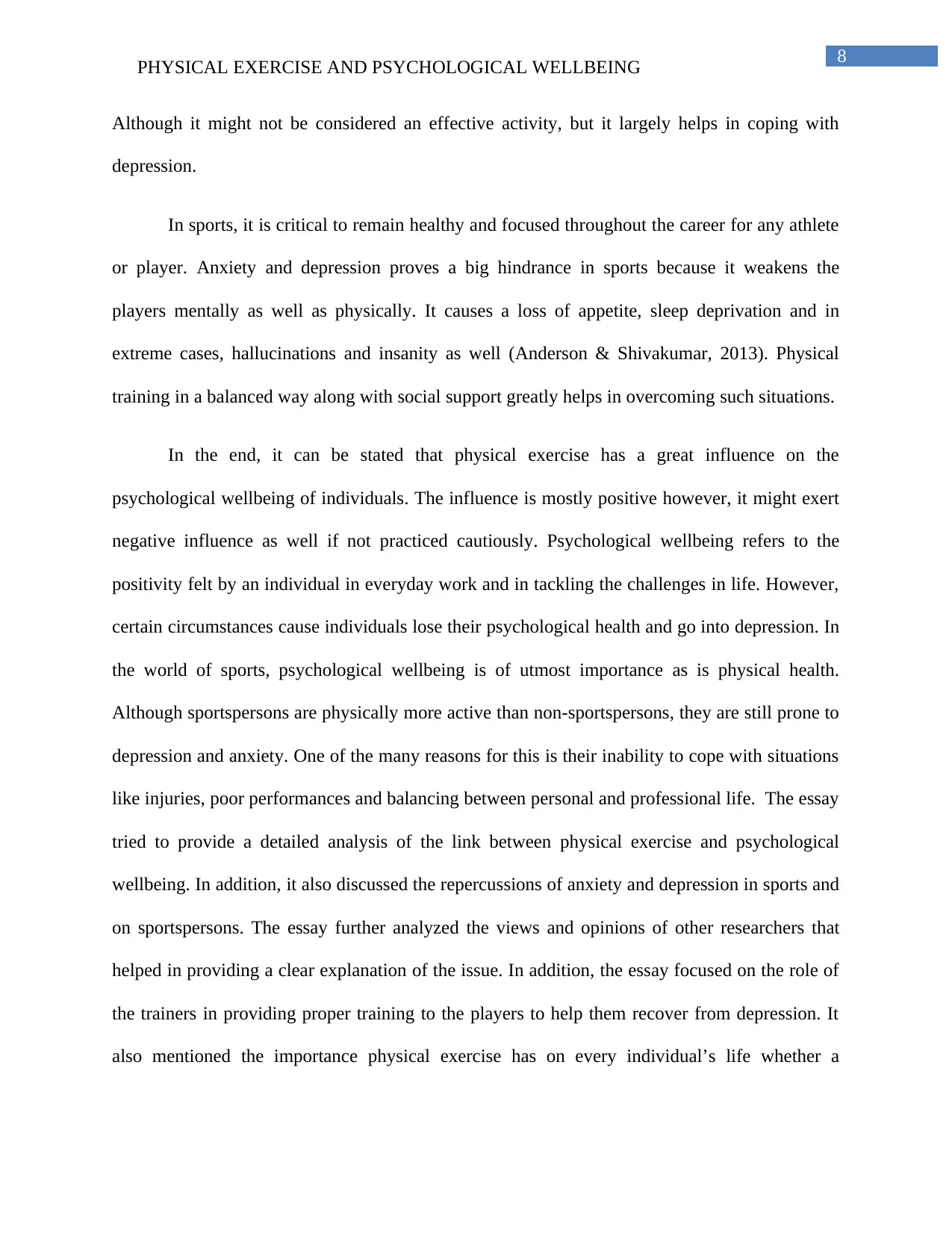
8
PHYSICAL EXERCISE AND PSYCHOLOGICAL WELLBEING
Although it might not be considered an effective activity, but it largely helps in coping with
depression.
In sports, it is critical to remain healthy and focused throughout the career for any athlete
or player. Anxiety and depression proves a big hindrance in sports because it weakens the
players mentally as well as physically. It causes a loss of appetite, sleep deprivation and in
extreme cases, hallucinations and insanity as well (Anderson & Shivakumar, 2013). Physical
training in a balanced way along with social support greatly helps in overcoming such situations.
In the end, it can be stated that physical exercise has a great influence on the
psychological wellbeing of individuals. The influence is mostly positive however, it might exert
negative influence as well if not practiced cautiously. Psychological wellbeing refers to the
positivity felt by an individual in everyday work and in tackling the challenges in life. However,
certain circumstances cause individuals lose their psychological health and go into depression. In
the world of sports, psychological wellbeing is of utmost importance as is physical health.
Although sportspersons are physically more active than non-sportspersons, they are still prone to
depression and anxiety. One of the many reasons for this is their inability to cope with situations
like injuries, poor performances and balancing between personal and professional life. The essay
tried to provide a detailed analysis of the link between physical exercise and psychological
wellbeing. In addition, it also discussed the repercussions of anxiety and depression in sports and
on sportspersons. The essay further analyzed the views and opinions of other researchers that
helped in providing a clear explanation of the issue. In addition, the essay focused on the role of
the trainers in providing proper training to the players to help them recover from depression. It
also mentioned the importance physical exercise has on every individual’s life whether a
PHYSICAL EXERCISE AND PSYCHOLOGICAL WELLBEING
Although it might not be considered an effective activity, but it largely helps in coping with
depression.
In sports, it is critical to remain healthy and focused throughout the career for any athlete
or player. Anxiety and depression proves a big hindrance in sports because it weakens the
players mentally as well as physically. It causes a loss of appetite, sleep deprivation and in
extreme cases, hallucinations and insanity as well (Anderson & Shivakumar, 2013). Physical
training in a balanced way along with social support greatly helps in overcoming such situations.
In the end, it can be stated that physical exercise has a great influence on the
psychological wellbeing of individuals. The influence is mostly positive however, it might exert
negative influence as well if not practiced cautiously. Psychological wellbeing refers to the
positivity felt by an individual in everyday work and in tackling the challenges in life. However,
certain circumstances cause individuals lose their psychological health and go into depression. In
the world of sports, psychological wellbeing is of utmost importance as is physical health.
Although sportspersons are physically more active than non-sportspersons, they are still prone to
depression and anxiety. One of the many reasons for this is their inability to cope with situations
like injuries, poor performances and balancing between personal and professional life. The essay
tried to provide a detailed analysis of the link between physical exercise and psychological
wellbeing. In addition, it also discussed the repercussions of anxiety and depression in sports and
on sportspersons. The essay further analyzed the views and opinions of other researchers that
helped in providing a clear explanation of the issue. In addition, the essay focused on the role of
the trainers in providing proper training to the players to help them recover from depression. It
also mentioned the importance physical exercise has on every individual’s life whether a
⊘ This is a preview!⊘
Do you want full access?
Subscribe today to unlock all pages.

Trusted by 1+ million students worldwide

9
PHYSICAL EXERCISE AND PSYCHOLOGICAL WELLBEING
sportsperson or not. It must however be suggested that further studies on the role of physical
exercise in helping people fight with acute illness be carried out.
PHYSICAL EXERCISE AND PSYCHOLOGICAL WELLBEING
sportsperson or not. It must however be suggested that further studies on the role of physical
exercise in helping people fight with acute illness be carried out.
Paraphrase This Document
Need a fresh take? Get an instant paraphrase of this document with our AI Paraphraser
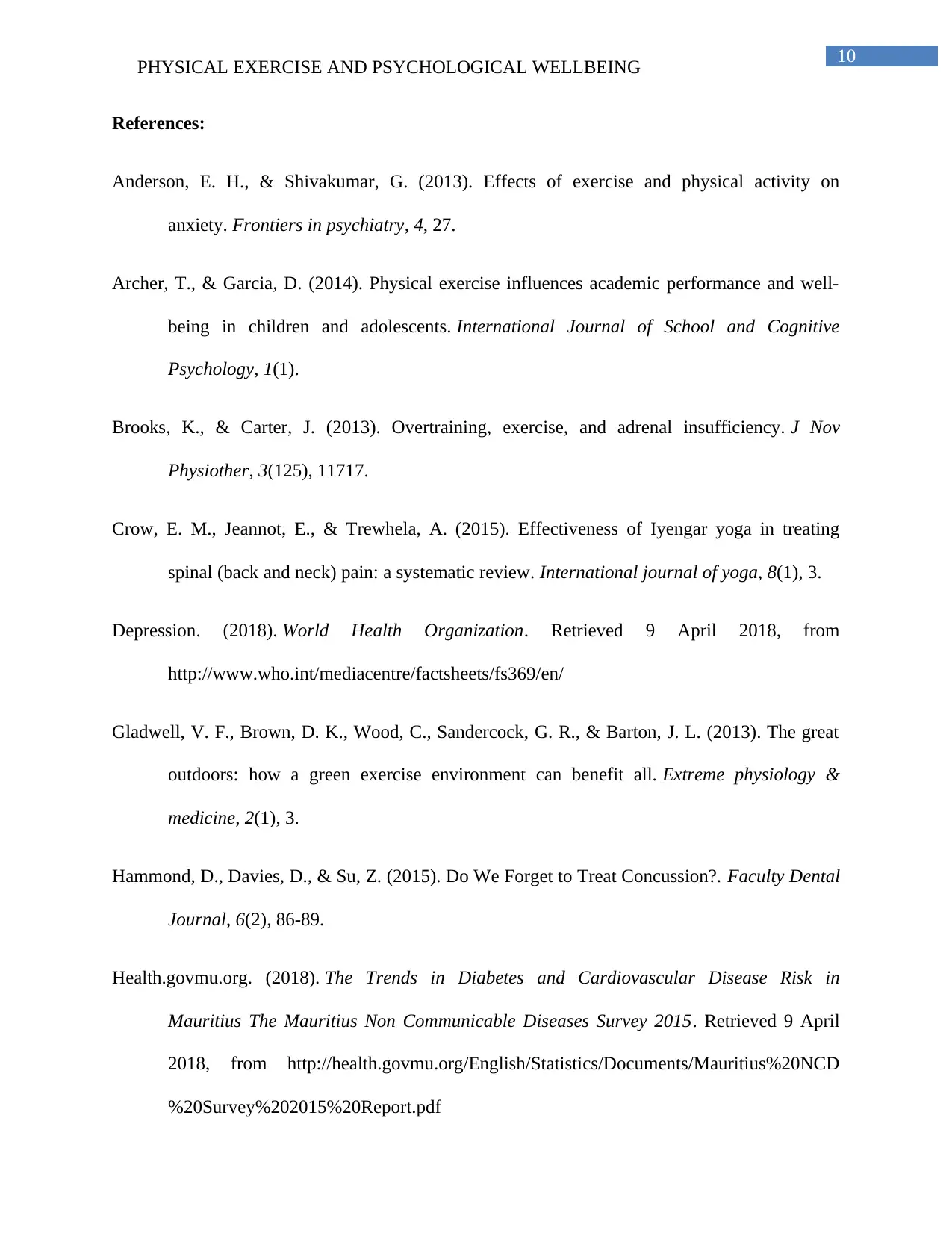
10
PHYSICAL EXERCISE AND PSYCHOLOGICAL WELLBEING
References:
Anderson, E. H., & Shivakumar, G. (2013). Effects of exercise and physical activity on
anxiety. Frontiers in psychiatry, 4, 27.
Archer, T., & Garcia, D. (2014). Physical exercise influences academic performance and well-
being in children and adolescents. International Journal of School and Cognitive
Psychology, 1(1).
Brooks, K., & Carter, J. (2013). Overtraining, exercise, and adrenal insufficiency. J Nov
Physiother, 3(125), 11717.
Crow, E. M., Jeannot, E., & Trewhela, A. (2015). Effectiveness of Iyengar yoga in treating
spinal (back and neck) pain: a systematic review. International journal of yoga, 8(1), 3.
Depression. (2018). World Health Organization. Retrieved 9 April 2018, from
http://www.who.int/mediacentre/factsheets/fs369/en/
Gladwell, V. F., Brown, D. K., Wood, C., Sandercock, G. R., & Barton, J. L. (2013). The great
outdoors: how a green exercise environment can benefit all. Extreme physiology &
medicine, 2(1), 3.
Hammond, D., Davies, D., & Su, Z. (2015). Do We Forget to Treat Concussion?. Faculty Dental
Journal, 6(2), 86-89.
Health.govmu.org. (2018). The Trends in Diabetes and Cardiovascular Disease Risk in
Mauritius The Mauritius Non Communicable Diseases Survey 2015. Retrieved 9 April
2018, from http://health.govmu.org/English/Statistics/Documents/Mauritius%20NCD
%20Survey%202015%20Report.pdf
PHYSICAL EXERCISE AND PSYCHOLOGICAL WELLBEING
References:
Anderson, E. H., & Shivakumar, G. (2013). Effects of exercise and physical activity on
anxiety. Frontiers in psychiatry, 4, 27.
Archer, T., & Garcia, D. (2014). Physical exercise influences academic performance and well-
being in children and adolescents. International Journal of School and Cognitive
Psychology, 1(1).
Brooks, K., & Carter, J. (2013). Overtraining, exercise, and adrenal insufficiency. J Nov
Physiother, 3(125), 11717.
Crow, E. M., Jeannot, E., & Trewhela, A. (2015). Effectiveness of Iyengar yoga in treating
spinal (back and neck) pain: a systematic review. International journal of yoga, 8(1), 3.
Depression. (2018). World Health Organization. Retrieved 9 April 2018, from
http://www.who.int/mediacentre/factsheets/fs369/en/
Gladwell, V. F., Brown, D. K., Wood, C., Sandercock, G. R., & Barton, J. L. (2013). The great
outdoors: how a green exercise environment can benefit all. Extreme physiology &
medicine, 2(1), 3.
Hammond, D., Davies, D., & Su, Z. (2015). Do We Forget to Treat Concussion?. Faculty Dental
Journal, 6(2), 86-89.
Health.govmu.org. (2018). The Trends in Diabetes and Cardiovascular Disease Risk in
Mauritius The Mauritius Non Communicable Diseases Survey 2015. Retrieved 9 April
2018, from http://health.govmu.org/English/Statistics/Documents/Mauritius%20NCD
%20Survey%202015%20Report.pdf
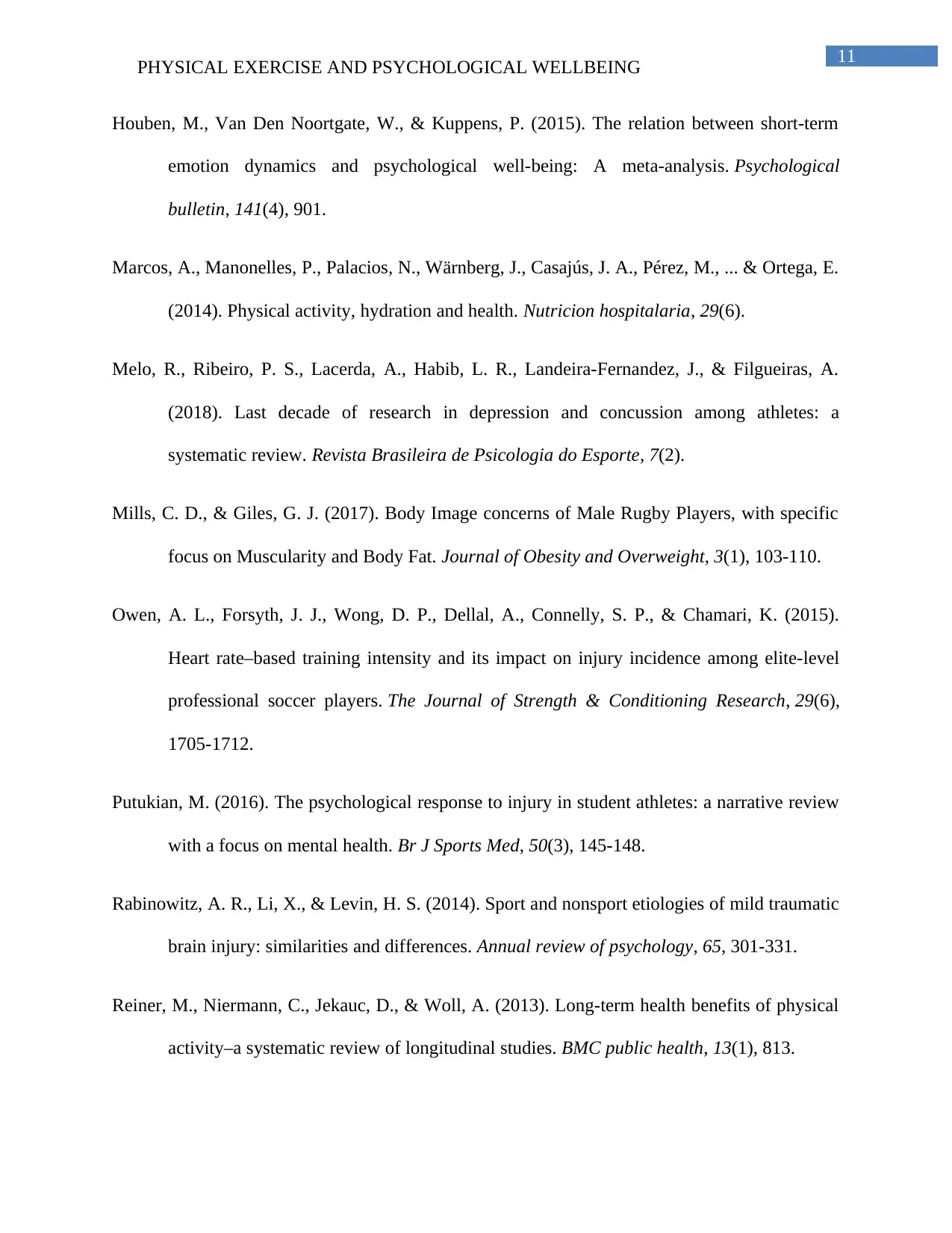
11
PHYSICAL EXERCISE AND PSYCHOLOGICAL WELLBEING
Houben, M., Van Den Noortgate, W., & Kuppens, P. (2015). The relation between short-term
emotion dynamics and psychological well-being: A meta-analysis. Psychological
bulletin, 141(4), 901.
Marcos, A., Manonelles, P., Palacios, N., Wärnberg, J., Casajús, J. A., Pérez, M., ... & Ortega, E.
(2014). Physical activity, hydration and health. Nutricion hospitalaria, 29(6).
Melo, R., Ribeiro, P. S., Lacerda, A., Habib, L. R., Landeira-Fernandez, J., & Filgueiras, A.
(2018). Last decade of research in depression and concussion among athletes: a
systematic review. Revista Brasileira de Psicologia do Esporte, 7(2).
Mills, C. D., & Giles, G. J. (2017). Body Image concerns of Male Rugby Players, with specific
focus on Muscularity and Body Fat. Journal of Obesity and Overweight, 3(1), 103-110.
Owen, A. L., Forsyth, J. J., Wong, D. P., Dellal, A., Connelly, S. P., & Chamari, K. (2015).
Heart rate–based training intensity and its impact on injury incidence among elite-level
professional soccer players. The Journal of Strength & Conditioning Research, 29(6),
1705-1712.
Putukian, M. (2016). The psychological response to injury in student athletes: a narrative review
with a focus on mental health. Br J Sports Med, 50(3), 145-148.
Rabinowitz, A. R., Li, X., & Levin, H. S. (2014). Sport and nonsport etiologies of mild traumatic
brain injury: similarities and differences. Annual review of psychology, 65, 301-331.
Reiner, M., Niermann, C., Jekauc, D., & Woll, A. (2013). Long-term health benefits of physical
activity–a systematic review of longitudinal studies. BMC public health, 13(1), 813.
PHYSICAL EXERCISE AND PSYCHOLOGICAL WELLBEING
Houben, M., Van Den Noortgate, W., & Kuppens, P. (2015). The relation between short-term
emotion dynamics and psychological well-being: A meta-analysis. Psychological
bulletin, 141(4), 901.
Marcos, A., Manonelles, P., Palacios, N., Wärnberg, J., Casajús, J. A., Pérez, M., ... & Ortega, E.
(2014). Physical activity, hydration and health. Nutricion hospitalaria, 29(6).
Melo, R., Ribeiro, P. S., Lacerda, A., Habib, L. R., Landeira-Fernandez, J., & Filgueiras, A.
(2018). Last decade of research in depression and concussion among athletes: a
systematic review. Revista Brasileira de Psicologia do Esporte, 7(2).
Mills, C. D., & Giles, G. J. (2017). Body Image concerns of Male Rugby Players, with specific
focus on Muscularity and Body Fat. Journal of Obesity and Overweight, 3(1), 103-110.
Owen, A. L., Forsyth, J. J., Wong, D. P., Dellal, A., Connelly, S. P., & Chamari, K. (2015).
Heart rate–based training intensity and its impact on injury incidence among elite-level
professional soccer players. The Journal of Strength & Conditioning Research, 29(6),
1705-1712.
Putukian, M. (2016). The psychological response to injury in student athletes: a narrative review
with a focus on mental health. Br J Sports Med, 50(3), 145-148.
Rabinowitz, A. R., Li, X., & Levin, H. S. (2014). Sport and nonsport etiologies of mild traumatic
brain injury: similarities and differences. Annual review of psychology, 65, 301-331.
Reiner, M., Niermann, C., Jekauc, D., & Woll, A. (2013). Long-term health benefits of physical
activity–a systematic review of longitudinal studies. BMC public health, 13(1), 813.
⊘ This is a preview!⊘
Do you want full access?
Subscribe today to unlock all pages.

Trusted by 1+ million students worldwide
1 out of 13
Related Documents
Your All-in-One AI-Powered Toolkit for Academic Success.
+13062052269
info@desklib.com
Available 24*7 on WhatsApp / Email
![[object Object]](/_next/static/media/star-bottom.7253800d.svg)
Unlock your academic potential
Copyright © 2020–2025 A2Z Services. All Rights Reserved. Developed and managed by ZUCOL.





